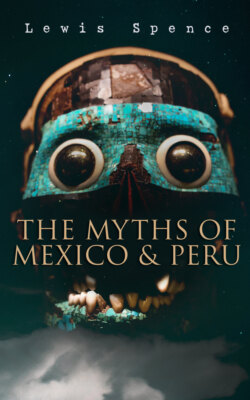Читать книгу The Myths of Mexico & Peru - Lewis Spence - Страница 29
На сайте Литреса книга снята с продажи.
Teotihuacan
ОглавлениеIn the district of the Totonacs, to the north of Vera Cruz, we find many architectural remains of a highly interesting character. Here the teocalli or pyramidal type of building is occasionally crowned by a covered-in temple with the massive roof characteristic of Maya architecture. The most striking examples found in this region are the remains of Teotihuacan and Xochicalco. The former was the religious Mecca of the Nahua races, and in its proximity are still to be seen the teocallis of the sun and moon, surrounded by extensive burying-grounds where the devout of Anahuac were laid in the sure hope that if interred they would find entrance into the paradise of the sun. The teocalli of the moon has a base covering 426 feet and a height of 137 feet. That of the sun is of greater dimensions, with a base of 735 feet and a height of 203 feet. These pyramids were divided into four stories, three of which remain. On the summit of that of the sun stood a temple containing a great image of that luminary carved from a rough block of stone. In the breast was inlaid a star of the purest gold, seized afterwards as loot by the insatiable followers of Cortés. From the teocalli of the moon a path runs to where a little rivulet flanks the “Citadel.” This path is known as “The Path of the Dead,” from the circumstance that it is surrounded by some nine square miles of tombs and tumuli, and, indeed, forms a road through the great cemetery. The Citadel, thinks Charnay, was a vast tennis or tlachtli court, where thousands flocked to gaze at the national sport of the Nahua with a zest equal to that of the modern devotees of football. Teotihuacan was a flourishing centre contemporary with Tollan. It was destroyed, but was rebuilt by the Chichimec king Xolotl, and preserved thenceforth its traditional sway as the focus of the Nahua national religion. Charnay identifies the architectural types discovered there with those of Tollan. The result of his labours in the vicinity included the unearthing of richly decorated pottery, vases, masks, and terra-cotta figures. He also excavated several large houses or palaces, some with chambers more than 730 feet in circumference, with walls over 7–1/2 feet thick, into which were built rings and slabs to support torches and candles. The floors were tessellated in various rich designs, “like an Aubusson carpet.” Charnay concluded that the monuments of Teotihuacan were partly standing at the time of the conquest.
